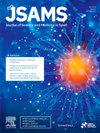颈部力量不足是高中橄榄球联盟和橄榄球联盟运动员脑震荡的危险因素。
IF 3
2区 医学
Q1 SPORT SCIENCES
引用次数: 0
摘要
目标:脑震荡的一级预防是接触性运动的首要任务,人们对颈部力量在降低脑震荡风险方面的作用越来越感兴趣。本研究旨在确定青少年橄榄球联盟和联赛运动员的颈部功能是否与赛季中的脑震荡有关,并确定临床值,以识别脑震荡风险增加的运动员:设计:前瞻性队列研究:方法:颈部功能评估包括等长肌力、耐力和本体感觉。记录赛季中的脑震荡受伤情况。初步建立多变量协方差分析模型,以研究在赛季中遭受和未遭受脑震荡的球员之间颈部功能的差异。如果有意义,则使用接收者操作特征曲线来确定每个变量的最佳切点,以区分脑震荡组别。未调整的几率是通过交叉表的卡方检验估算出来的。显著性以 p 为标准:共有 43 名球员(15-18 岁)在季前赛期间接受了评估。有 11 名球员在赛季中出现脑震荡。以公斤为单位(p = 0.043,效应大小 = 0.74),当与体重归一化时(p = 0.041,效应大小 = 0.74),在赛季中遭受脑震荡的球员颈部伸展力量较弱。伸展力量的最佳切点为 32.1 千克(灵敏度 0.64,特异性 0.75)和 3.71 牛/千克(灵敏度 0.64,特异性 0.66)。屈伸力量比率超过 0.74 的球员发生脑震荡的可能性要高出 3 倍(p = 0.09)。其他颈部功能变量没有差异:结论:针对颈部力量的干预措施可以降低脑震荡的风险。本文章由计算机程序翻译,如有差异,请以英文原文为准。
Neck strength deficit is a risk factor for concussion in high school rugby union and rugby league players
Objectives
Primary prevention of concussions is a priority in contact sports, with growing interest in the role of neck strength in mitigating the risks of concussion. The aim of this study was to determine if neck function was associated with in-season concussions in adolescent rugby union and league athletes, and to establish clinical values to identify players with increased risk of sustaining a concussion.
Design
Prospective cohort study.
Methods
Assessment of neck function included isometric strength, endurance and proprioception. In-season concussion injuries were recorded. Preliminary multivariate analysis-of-covariance models were conducted to investigate differences in neck function between players who did and did not sustain an in-season concussion. If significant, receiver operated characteristic curves were used to determine optimal cut-points for each variable to distinguish between concussion groups. Unadjusted odds ratios were estimated from the cross tabulation chi-squared test. Significance was set at p < 0.1.
Results
A total of 43 players (aged 15–18 years) were assessed during preseason. Eleven players sustained a concussion during the season. Players who sustained a concussion during the season had weaker neck extension strength in kilogrammes (p = 0.043, effect size = 0.74) and when normalised to body weight (p = 0.041, effect size = 0.74). The optimal cut-point for extension strength was 32.1 kg (sensitivity 0.64, specificity 0.75) and 3.71 N/kg (sensitivity 0.64, specificity 0.66). Players with a flexor to extensor strength ratio above 0.74 were 3-times more likely to sustain a concussion (p = 0.09). There were no differences for other neck function variables.
Conclusions
Interventions targeting neck strength could reduce the risk of concussion.
求助全文
通过发布文献求助,成功后即可免费获取论文全文。
去求助
来源期刊
CiteScore
7.40
自引率
10.00%
发文量
198
审稿时长
48 days
期刊介绍:
The Journal of Science and Medicine in Sport is the official journal of Sports Medicine Australia (SMA) and is an an international refereed research publication covering all aspects of sport science and medicine.
The Journal considers for publication Original research and Review papers in the sub-disciplines relating generally to the broad sports medicine and sports science fields: sports medicine, sports injury (including injury epidemiology and injury prevention), physiotherapy, podiatry, physical activity and health, sports science, biomechanics, exercise physiology, motor control and learning, sport and exercise psychology, sports nutrition, public health (as relevant to sport and exercise), and rehabilitation and injury management. Manuscripts with an interdisciplinary perspective with specific applications to sport and exercise and its interaction with health will also be considered.

 求助内容:
求助内容: 应助结果提醒方式:
应助结果提醒方式:


